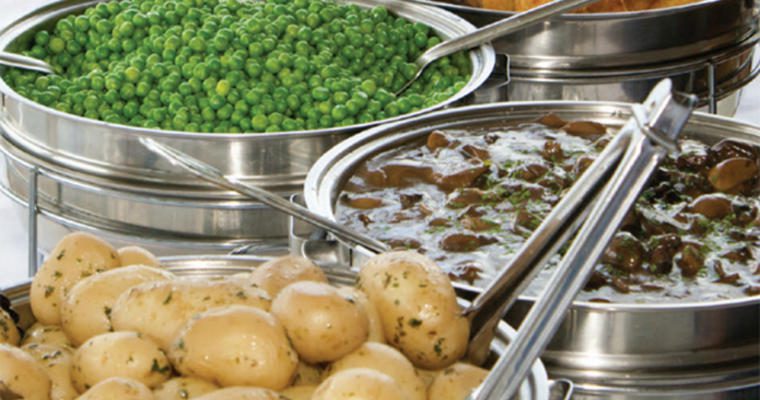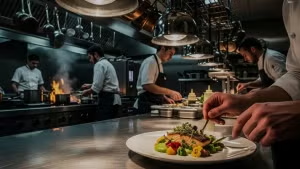As the healthcare industry continues to focus on controlling costs and improving the bottom line, food catering can provide additional sales-building opportunities in healthcare centers. Healthcare catering offers benefits for both acute-care and senior-living centers. Within these segments are two sub-categories, internal and external catering.
Two Ways to Offer Food Catering
1) Internal Catering Opportunities
Internal catering—which serves staff, patients, and/ or residents—is the easiest and most common form of catering for healthcare operators. At the Spectrum Health Network in greater Grand Rapids, Michigan, internal catering is used for departmental meetings, open houses, retirement parties, baby showers, events celebrating new buildings, and more.
“Our primary goal is patient safety and satisfaction, so we choose to keep everything internal in order to maintain this focus,” says Tessa Langeland, Catering Specialist at Spectrum Health’s Blodgett Campus.
For senior-living, internal catering has an important role in the culture-change movement, as it gives residents a way to entertain in a very personal way “at home.” The idea is to allow residents to do anything they would be able to do at home. If a patient wants to throw a baby shower, why can’t they? Offering internal catering makes it much easier to host families for holiday meals, throw a shower for a niece, or bring friends together for a social gathering.
2) External Catering Opportunities
While internal catering might often be the first step taken, external catering also offers an opportunity to expand healthcare-foodservice operations. External catering opportunities can be as simple as advertising community rooms for local groups, hosting meetings catered by your center, providing dinner to the local Red Hat Society, or takeaway catering picked up by customers.
The Chicago-based research firm Technomic Inc.’s most recent study on the B2B catering market, Large Orders Off-Premise, revealed an $18.5 million opportunity. The report also indicated significant potential for an alternate revenue stream for foodservice operators. Prime catering opportunities, such as large orders from medical offices, enable healthcare-foodservice operators to build their business.
Certain culinary considerations are necessary when developing catering menu options for healthcare locations. These include what foods should be placed on the menu, what travels well, and what meets the special needs of patients, residents, and visitors.Healthcare foodservice operators are well suited to serve meals that meet these requirements
In the cost-cutting, eye-on-the-bottom-line world of healthcare, it’s also important to consider what resources and tools can be leveraged to assist with building revenue and profitability. Catering provides the chance for kitchen space, equipment, and staff to be cross-utilized without additional expenditures.
Try looking at the dollars and cents of the catering operation. Make sure you’re charging correctly. Are you accounting for all of your expenses? While food and beverage costs may help determine the total cost for external or internal catering events, operators should not overlook labor costs, especially when opening an operation up to external catering. When external catering means off-site catering, being prepared to handle many demands is key. If your hospital or senior-living community operates multiple locations, you may already have trucks or vans to help transport catered meals to various locations, in addition to the staff that’s necessary to ensure your operation runs smoothly.
Technomic reports that food quality and freshness are the most critical drivers in consumers’ selection of a catering vendor; for healthcare facilities, food safety is of the utmost importance. Always follow strict food-safety procedures when catering on- or off-site. Follow these tips, to ensure that foods are kept safe while being transported.
These tips can help prevent the growth of potentially harmful bacteria:
Cool Hot food That Will Be Reheated
- Cool potentially hazardous foods from 135°F to 70°F within two hours, and from 70°F to 41°F within four hours (six hours total).
- Chill food to below 41°F before transport.
- Divide large batches of food into smaller ones, place them in small metal pans in the refrigerator, freezer, or an ice-water bath, and stir often to dissipate heat.
Transportation
- Make sure transporters are clean and rust-free, and that food containers are sanitized and sealed.
- Preheat or pre-chill transporters according to the manufacturer’s instructions before loading.
- For food, use shallow pans (2-2½ inches deep) with fitted lids.
- Document adequate temperature/humidity controls for all perishable and potentially hazardous foods.
- Pack hot and cold items separately.
- Document food temperature on arrival.
Food-safety guidelines require foods to remain covered until the dish is served to a patient or resident. Follow this practice when serving catering customers, as well, both on- and off-site.
Promoting Catering Services
Promoting catering services is just as important for healthcare operators as it is for restaurants. “We primarily use word-of-mouth for catering services,” says Theresa DeWit, Catering Coordinator at Spectrum Health’s Butterworth campus. “We are working with our system communication and marketing team to produce paper marketing materials to expand our services throughout the hospital. Our goal for the catering department is to provide quality food and beverages at competitive pricing.”
Promoting catering services to patients/residents and employees is just as important. By cross-promoting catering services on lunchtime menus, hanging signs in cafeterias and employee lounges, or creating table tents, you can provide increased visibility for catering services, which helps drive sales and more opportunities.
Holidays offer especially good opportunities for promoting catering services within your operation and the community. In addition, holiday menus give your chefs an opportunity to show off their creativity. Moreover, they can help you target new markets. Create holiday menus that help residents entertain their families, and offer catering that is a convenience to employees and local residents. Remember, even little touches, such as offering colored eggs for Easter, can lift a resident’s spirits. Whatever you add to your holiday menus, be sure to keep dietary restrictions in mind.
For More Information
Ask your Gordon Food Service Customer Development Specialist how user-friendly, customizable templates from LTO Direct can help you create branded, limited-time offer (LTO) signage, table tents, comment cards, and other marketing materials that can build catering sales.











